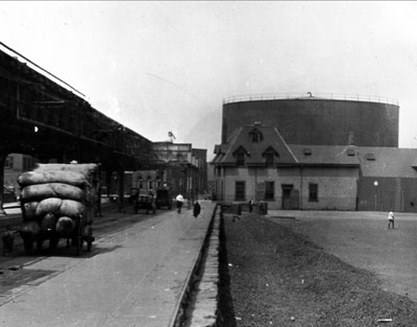On the day that Boston’s Great Molasses Flood came in 1919, over 2 million gallons of the thick sugary syrup burst out of a giant storage tank and coursed through the streets in the city’s North End. The wave of molasses reached at least 15 feet high at one point and raced towards its victims at 35 mph.
The molasses had so much force that it thrust a truck into Boston Harbor, knocked a streetcar off its tracks, and pushed houses off their foundations.
Boston’s Great Molasses Flood claimed 21 lives and injured over 150 people. Cleanup took weeks. Crews sprayed salt water to remove the molasses from every surface imaginable–subway platforms, inside streetcars, pay telephones, even inside public buildings. Pedestrians tracked the molasses everywhere they went.
For weeks, all of Boston was sticky. Boston Harbor stayed brown for months. And for decades, Bostonians said that the streets near the disaster site smelled like molasses on hot summer days.
In the century-plus since that molasses tank burst on January 15, 1919, the Boston Molasses Disaster has become part of Boston lore, but …
Why did Boston have a 2.3 million gallon tank of molasses in the North End?

The Purity Distilling Company built the molasses tank in 1915 and made it large: 50 feet high by 90 feet wide. The company used the molasses in the tank to make ethanol, which in turn helped create munitions for World War I and alcohol that eventually found its way into beverages like beer, wine, and brandy.
On Boston’s Commercial Street, the tank received molasses from ships coming into Boston Harbor. Later, Purity transferred the molasses by its pipeline to its ethanol plant in nearby Cambridge.
The Molasses Flood’s connection with Prohibition and World War I
By the time January 1919 rolled around, the end of World War I and the coming of Prohibition threatened to dry up Purity’s two main sales channels. Months earlier, the abdication of the kaiser in Germany and the signing of the Armistice of November 11 meant the end of World War I. And, in mid-January 1919, the 18th Amendment to the US Constitution was ratified, which would make the making, selling, and transport of alcohol illegal.
As the WWI munitions race and the flow of free alcohol was coming to an end, Purity raced to sell all that molasses it held in its tank. And they wanted to do it before Prohibition went into effect in 1920. There’s only so much molasses you can sell for cookies.
How the Great Molasses Flood brought us class-action lawsuits
When the molasses tank burst, the public wondered whether Italian anarchists had blown it up. Purity Distilling Company hoped so. When it turned out that the tank failed as a result of a lot of neglect, victims and their families sued. The lawsuits were combined into one big lawsuit, one of the state’s first class-action lawsuits.
A lot of corners were cut in building the tank. Purity never properly tested it for leaks. They tried to hide stains left by leaking molasses by painting the tank brown. Neighborhood kids brought buckets and jugs to catch molasses that dripped from the tank.
And, the tank was known to groan when it was full.
Even while the company maintained that the tank failed because it was sabotaged by Italian anarchists, a multi-year investigation involving more than 1,000 witnesses determined the company was at fault. The victims’ families eventually received $628,000 in damages, which is over $9 million when adjusted for inflation in 2020.
And the class-action lawsuit was born.
Conclusion
Across all of Boston’s newspapers, the Great Molasses Flood seized front-page headlines for days after it happened. The molasses flood garnered enough attention to push the beginning of the talks that became the World War-ending Treaty of Versailles below the fold. It also overshadowed the passing of the 18th Amendment to the US Constitution, which brought us Prohibition.
Today, the Great Molasses Flood lives on in Boston lore as well as in its construction regulations, which now require licensed architects and civil engineers to be involved in the drafting of project requirements. The legacy of the flood also lives on in the corporate responsibility encouraged by the specter of class-action lawsuits.
The tank was never rebuilt and the land eventually came under the control of a predecessor for the MBTA. Today, a recreational complex owned by the City of Boston occupies the site. A small, green plaque marks the spot of the disaster:

Header Image Credit: The aftermath of the Boston molasses explosion (LoC/PD)

Thanks so much, Ryan. I always wanted to learn more about this horrible incident. It happened the year my mother was born, and my father was five years old, living in the North End. Great photos and article, as always,
Loved the history story of this horrible accident, and the future laws that it had on present day building practices.
The Eighteenth Amendment creating Prohibition was ratified THE NEXT DAY!
So crazy! Great story but so horrible